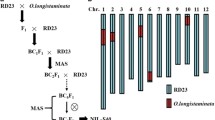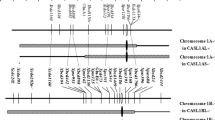Summary
A locus for male gamete abortion in hybrids for Japonica and Indica rice was identified with the aid of marker genes Rc and Est-9 on chromosome 7. In an Indica-Japonica cross, AKAMAI 1/IR50, the Indica allele Est-9 2 was transmitted via the male gamete with a ratio of 0.29 instead of the normal 0.5, whereas no segregation distortion was observed for the Rc locus. The recombination value (p) for Est-9 and Rc was estimated to be 0.38 by a least square method after adjusting Mendelian segregation ratios with the male transmission ratios of 0.29 (Tr) for Est-9 2 and 0.71 (1-Tr) for Est-9 1. The recombination value (q) for the new locus for male gamete abortion, ga-11, and Est-9 was estimated to be 0.23 by using 56 F3 lines from F2 plants which were heterozygous for the Est-9 locus. No linkage for Rc and ga-11 was found. Therefore, the two markers and ga-11 were located in the order of ga-11-Est-9-Rc. Using the estimated recombination value (q), the male transmission rate (k) of ga-11 a was estimated to be 0.11 with the F2 data and-0.07 with the F3 line data. Thus, it was apparent that male gametes possessing ga-11 a were frequently aborted in the Indica-Japonica hybrid.
Similar content being viewed by others
References
Guiderdoni, E., B.Corutois & J.C.Glaszmann, 1989. Use of isozyme markers to monitor recombination and assess gametic selection among anther culture derivatives of remote crosses of rice (Oryza sativa L.). In: A.Mujeeb-Kazi & L.A.Sitch (Eds.) Review of advances in plant biotechnology, 1985–88: 2nd International Symposium on Genetic Manipulation in Crops. Mexico, D.F., Mexico, and Manila, Philippines: CIM-MYT and IRRI. pp. 43–55.
Ikehashi, H. & H.Araki, 1986. Genetics of F1 sterility in remote crosses of rice. Rice Genetics, p. 119–130. IRRI, Los Banos, Philippines.
Ikehashi, H. & H.Araki, 1988. Multiple alleles controlling F1 sterility in remote crosses of rice (Oryza sativa L.). Jpn. J. Breed. 38: 283–291.
Ishikawa, R., T.I.Sato & H.Morishima, 1987a. Abnormal segregation of isozyme genes in the Indica x Japonica crosses of the common rice. Jpn. J. Breed. 37 (Suppl. 2): 188–189 (In Japanese).
Ishikawa, R., T.Kinoshita & H.Morishima, 1987b. Trisomic analysis of genes for isozymes: Location of Cat-1, Acp-1 and Pox-2 on chromosomes. Rice Genet. Newslett. 4: 75–76.
Ishikawa, R., H.Morishima, K.Mori & T.Kinoshita, 1989. Chromosomal analysis of isozyme loci and the allelic expression at cellular level in rice. J. Fac. Agric. Hokkaido Univ. (Japan) 64: 85–98.
Iwata, N., T.Nagamatsu & J.Omura, 1964. Abnormal segregation of waxy and apiculus coloration by a gametophyte gene belonging to the first linkage group in rice. Jpn. J. Breed. 14: 33–39.
Jones, J.W. & A.E.Longley, 1941. Sterility and aberrant chromosome numbers in Caloro and other varieties of rice. J. Agr. Rec. 62: 381–399.
Kato, S., 1930. On the affinity of the cultivated varieties of rice plants Oryza sativa L. J. Dep. Agr. Kyushu Imp. Univ. 2: 241–276.
Kinoshita, T. & I.Takamure, 1984. Inheritance and zebra nebra necrosis in rice-Genetical studies on rice plant, LXXXVIII. J. Fac. Agr. Hokkaido Univ. 61: 445–455.
Kitamura, E., 1962. Genetic studies on sterilities observed in hybrids between distantly related varieties of rice, Oryza sativa L. Bull. Chugoku Agr. Exp. Sta. Series A, 8, 141–205. (In Japanese, with English summary).
Kuang, H., 1951. Studies on rice cytology and genetics as well as breeding work in China. Agron. J. 43: 387–397.
Lin, S.Y., H.Ikehashi, S.Yanagihara, K.Kawashima, 1992. Segregation distortion via male gametes in hybrids between Indica and Japonica or wide-compatibility varieties of rice (Oryza sativa L.). Theor. Appl. Genet. 84: 812–818.
Maekawa, M., 1982. Studies on genetical differentiation in distant crosses of rice. Mem. Fac. Agr. Hokkaido Univ. 13: 147–177 (In Japanese with English summary).
Maekawa, M., T.Kinoshita & M.Takahashi, 1981. Genetical studies on rice plant. LXXVI. A new gametophyte gene in the second linkage group of rice. J. Fac. Agr. Hokkaido Univ. 60: 107–114.
Maekawa, M. & F.Kita, 1985. New gametophyte genes located inthe third linkage group (chromosome 3) of rice. Jpn. J. Breed. 35: 25–31.
McCouch, S.R., G.Kochert, H.Z.Yu, Z.Y.Wang, G.S.Khush, W.R.Coffman & S.D.Tanksley, 1988. Molecular mapping of rice chromosomes. Theor. Appl. Genet. 76: 815–829.
Mori, K., T.Kinoshita & M.Takahashi, 1973. Genetical studies on rice plant. LVIII. Segregation distortion and its causation of an endosperm character in crosses of distantly related rice varieties. Mem. Fac. Agr. Hokkaido Univ. 9: 74–86 (In Japanese with English summary).
Nakagahra, M., 1972. Genetic mechanism on the distorted segregation of marker genes belonging to the eleventh linkage group in cultivated rice. Jpn. J. Breed. 22: 232–238.
Nakagahra, M., 1981. New distorted inheritance of markers located on chromosome 3 in wide crosses of rice Oryza sativa L. Bull. Nat. Inst. Agr. Sci. D 32: 15–44 (In Japanese with English summary).
Nakagahra, M., T.Omura & N.Iwata, 1972. Gametophyte genes and their loci on the eleventh linkage group of cultivated rice. Jpn. J. Breed. 22: 305–312.
Nakagahra, M., T.Omura & N.Iwata, 1974. New certation gene on the first linkage found by inter-subspecific hybridization of cultivated rice. J. Fac. Agr. Kyushu Univ. 18: 157–167.
Oka, H., 1974. Analysis of genes controlling F1 sterility in rice by the use of isogenic lines. Genetics. 77: 521–534.
Ranjhan, S., J.C.Glaszmann, D.A.Ramirez & G.S.Khush, 1988. Chromosomal localization of four isozyme loci by trisomic analysis in rice (Oryza sativa. L.). Theor. Appl. Genet. 75: 741–745.
Saito, A., E.Shimosaka, Y.Hayano, K.Saito, S.Matuura & M.Yano, 1991. Molecular mapping on chromosome 3 of rice. Jpn. J. Breed. 41 (Suppl. 1): 158–159 (In Japanese).
Shastry, S.V.S. & R.N.Misra, 1961. Pachytene analysis in Oryza II. Sterility in Japonica-Indica hybrids. Chromosome 12: 248–271.
Terao, H. & U.Mizushima, 1939. Some considerations on the classification of Oryza sativa L. into two subspecies, so-called ‘Japonica’ and ‘Indica’. Jpn. J. Bot. 10: 213–258.
Wu, K.S., J.C.Glaszmann & G.S.Khush, 1988. Chromosomal locations of ten isozyme loci in rice (Oryza sativa L.) through trisomic analysis. Biochemical Genetics 26: 303–320.
Yanagihara, S., H.Kato & H.Ikehashi, 1992. A new locus for multiple alleles causing hybrid sterility between an Aus variety and Javanica varieties in rice (Oryza sativa L.). Jpn. J. Breed. 42: 793–801.
Author information
Authors and Affiliations
Rights and permissions
About this article
Cite this article
Lin, S.Y., Ikehashi, H. A gamete abortion locus detected by segregation distortion of isozyme locus Est-9 in wide crosses of rice (Oryza sativa L.). Euphytica 67, 35–40 (1993). https://doi.org/10.1007/BF00022722
Received:
Accepted:
Issue Date:
DOI: https://doi.org/10.1007/BF00022722




